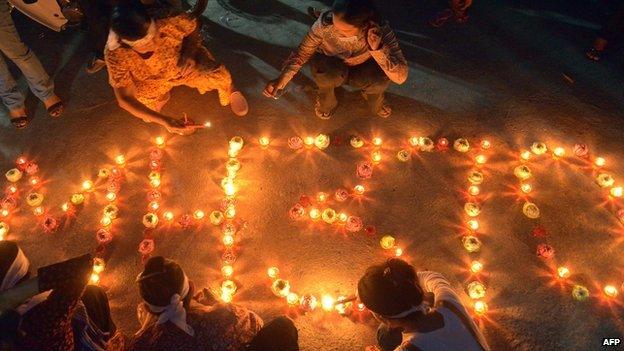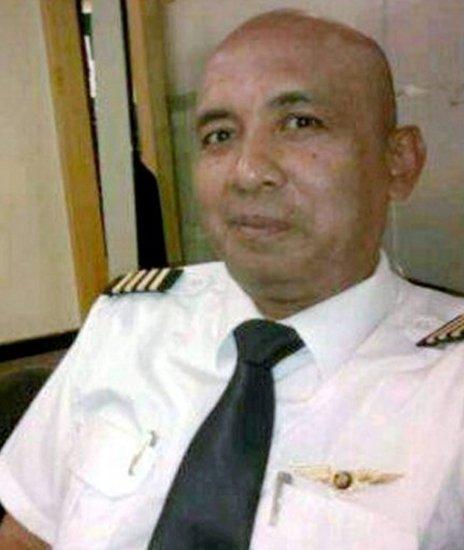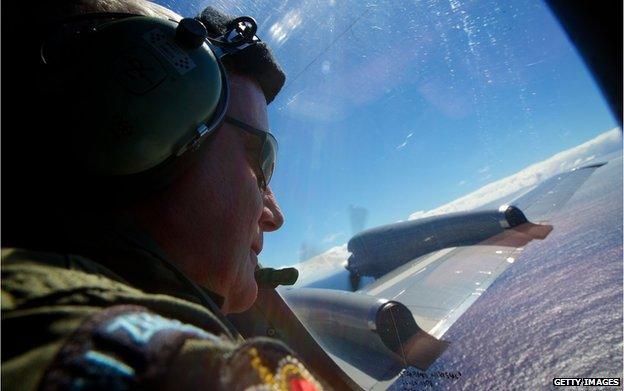Flight MH370: Could it have been suicide?
- Published

A year after the disappearance of a Malaysia Airlines plane with 239 on board, investigators still don't know what happened. Could pilot suicide have been the cause?
"Someone was looking at Penang. Someone was taking a long, emotional look at Penang. The captain was from the island of Penang."
There are times when Captain Simon Hardy's analysis of flight MH370 sends shivers down the spine, especially in the light of the recent case of Germanwings Airbus flight 4U 9525.
An experienced Boeing 777 captain, he knows the Asian air routes like a commuter knows short cuts home. He flew them them for 17 years.
He's convinced about something that no pilot, no passenger, nobody in fact wants to think is possible - that the captain of the flight, Zaharie Shah, deliberately hid the plane from radar and flew it thousands of miles off course, before it came down in the ocean.
He says the clues are in the route it took after it vanished from air traffic control. It turned back on itself and flew along the border of Malaysia and Thailand.
"It flew in and out of the countries eight times," he says. "This is probably very accurate flying rather than just a coincidence. As both air traffic controllers in both those countries would probably assume that the aircraft was in the other country's jurisdiction and not pay it any attention."

Captain Zaharie Shah
But his most eerie theory comes a little later, as the aircraft skirts around the captain's home island, Penang,
"It does a strange hook," he says. "I spent a long time thinking about this and eventually I found that it was a similar manoeuvre to what I'd done in Australia over Ayers Rock. Because the airway goes directly over Ayers Rock you don't actually see it very well because it disappears under the nose of the aircraft.
"So in order to look at it you have to turn left or right, get alongside it and then execute a long turn. If you look at the output from Malaysian 370, there were actually three turns not one. Someone was looking at Penang."
Two experienced pilots explain what they think may have happened to flight MH370
Steve Landells, who flew Boeing 777s for a decade and is now a flight safety expert at the British Airline Pilots Association, external, is still baffled as to what happened to flight MH370. "None of the theories answer all the questions or fully explain what did happen that day", he says.
There is so much we don't know, but we do know the route it flew between 00:41am local time (take-off), and the last military radar fix at 02:22am. It shows the aircraft making a series of inexplicable turns. After that the assumption, based on the skinniest of data from a satellite, is that it flew south in a straight line for six hours.
"A lot of the theories pre-suppose that there was no-one there to fly the aircraft, but there are only three ways to turn a 777," says Landells. "That's manually flying it, actually turning the control wheel, flying it through the autopilot, or by pre-programming a route into the navigation computer. The problem with the first two is that you have to have someone in the cockpit. But if there was someone in the cockpit, why were there no radio calls made?"
The 777 has many back-up systems for its electrics, says Landells, so even if all fail, there's a battery connected to the captain's instruments and one of the radios, so a call could have been made. Even if that fails, there's a propeller that drops out the back of the aircraft, called a ram air turbine, that provides enough electrical power to run the basic facilities, including a radio.
"The other possibility is a severe fire in the cockpit, which has happened in the past," says Landells. "That might mean that the pilots would have to leave the cockpit. But if that was the case, then how did the aircraft continue flying for so long, with such a catastrophic fire going on? It's very, very unlikely."

The uncertainty prompts an uncomfortable question. Did pilot Zaharie Shah crash the plane on purpose, killing himself, the crew and the passengers? Such incidents are very rare. The US Aviation Safety Network, external lists only eight airline accidents in the whole of aviation history that are thought possibly to have been caused by pilot suicide. Rare, but not unheard of.
"We know what happened," David Learmount, safety editor at Flight Global, has said of MH370. "There's only one thing it can be - a deliberate act by someone on board, probably the captain."
But the idea is highly controversial.
"The pilot suicide theory for flight MH370 has gained traction because, throughout the last year, there's been no evidence of an outside plot," says aviation writer Sylvia Spruck Wrigley.
"Nothing's come up on social media. No-one is claiming responsibility. But the way MH370 happened seems an unlikely way to commit suicide - allowing the plane to continue going for so long. In the very rare cases of pilot suicide, it usually happens much quicker, just pointing the plane at the ground and crashing it."
A year after MH370's disappearance, it's incredible that one of the biggest searches in history hasn't turned up one seat cover, one piece of luggage, an oxygen mask, any physical clue at all as to the whereabouts of the plane.

The search for the missing plane has been one of the biggest in history
In 1937, when pilots used to navigate by the sun and the stars, one of the world's most famous women, Amelia Earhart, disappeared in her plane over the Pacific Ocean. Theories have proliferated ever since. Everything from her being a spy, to her living out her days as a New Jersey housewife, running from fame.
The story still makes headlines. Only last week I spoke to a man who has spent decades trying to find her plane, and is even now planning a trip to a remote island to follow up on another "clue".
I shudder to think that in eight decades' time people will be watching our old news reports, as yet another expedition sets off to solve the mystery of flight MH370.

Suspected pilot suicides
1976 - Russia - A pilot stole an Antonov 2 biplane and flew it into the block of flats in Novosibirsk where his divorced wife lived. Two deaths.
1979 - Colombia - A recently fired mechanic stole a military HS-748 transport plane, taking off and crashing into a residential area of Bogota. Four deaths.
1994 - Russia - An air force engineer stole an Antonov 26 transport plane from the Kubinka base, near Moscow. The pilot circled the town of Kubinka until the plane ran out of fuel. One death.
1994 - Morocco - A Royal Air Maroc ATR-42 crashed in the Atlas Mountains shortly after takeoff. It was suggested the captain had disconnected the autopilot and directed it at the ground, but the Moroccan Pilots' Union challenged this. 44 deaths.
1997 - Indonesia - A Silk Air Boeing 737 crashed en route to Singapore. It was suggested the captain may have committed suicide by switching off both flight recorders and intentionally putting the plane into a dive. 104 deaths.
1999 - Botswana - A captain stated over the radio that he was going to crash an ATR-42 plane. It hit two other aircraft parked at Gaborone Airport. One death.
1999 - US - An Egypt Air Boeing 767 entered a rapid descent half an hour after takeoff from New York's JFK Airport, moments after the captain had left the flight deck. It was suggested the accident had been deliberately caused by the relief first officer, but there was no conclusive evidence. 217 deaths.
2013 - Namibia - An LAM Mozambique Airlines Embraer ERJ-190 entered a rapid descent en route from Mozambique to Angola. Preliminary investigation results indicate the accident was intentional. 33 deaths.
2015 - France - Co-pilot of a Germanwings Airbus A320 Andreas Lubitz believed to have deliberately crashed the plane in the French Alps en route to Dusseldorf, killing 150 people.
Source: Aviation Safety Network

Subscribe to the BBC News Magazine's email newsletter to get articles sent to your inbox.